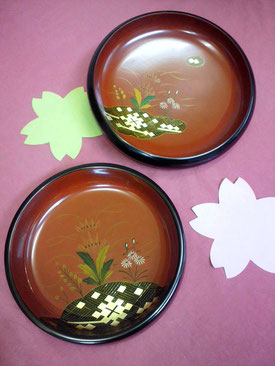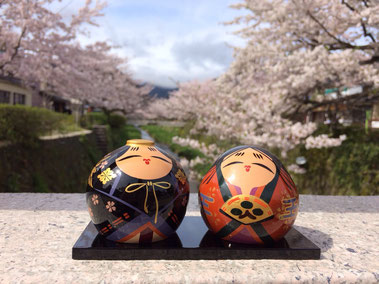◆ 大内塗の歴史◆ History of Ouchi-nuri

室町時代、絢爛豪華な大内文化の象徴として誕生した大内塗は、当時大内氏の朝鮮・シナ大陸における重要な交易品として扱われておりました。
主に、椀や盆、花器などが代表的で、「大内朱」と呼ばれる朱色や大内家の家紋を模して金箔(きんぱく)であしらった「大内菱(おおうちびし)」、秋草模様が大内塗の特徴です。
なかでも丸顔におちょぼ口、切れ長の目もとが特徴の、とても愛らしい表情をした大内人形は、夫婦円満の象徴として見る人の心を和ませ、お土産物としてもとても人気の高い商品です。
Ouchi-nuri was born in the Muromachi period (1333-1573) as a symbol of the gorgeous Ouchi culture, and was treated as an important trading article of the Ouchi clan in Korea and the Sino-American continent at that time.
The main representative items are bowls, trays, and flower vases, and the vermilion color called "Ouchi-shu", the "Ouchibishi" decorated with gold leaf in the shape of the Ouchi family crest, and the autumn grass pattern are the characteristics of Ouchi-nuri.
The Ouchi dolls, with their round faces and long slit eyes, are very popular as souvenirs because they are a symbol of conjugal bliss and bring peace to the hearts of those who see them.
◆ 大内人形のお話◆ Story of Ouchi Dolls

山口の地に居を構えた大内弘世は、多くの人を都から山口に招き、都と同じような街づくりを始め、やがて京の三条家から美しい花嫁を迎えます。しかし花嫁は遠く華やかな都を恋しがり、いつも泣いてばかりおりました。 心の優しい弘世はかわいそうに思い、都から多くの人形職人を呼び寄せ、屋敷中を人形でいっぱいにしました。 花嫁はたいそう喜び、それからは幸せに二人仲良く暮らしました。
やがて街の人々は、そんな弘世の屋敷を「人形御殿」と呼ぶようになり、やがてそのうわさは遠く都まで届くほどになりました。 その頃京で長く続いていた戦乱にあきあきしていた都の貴族、文化人、芸術家、僧侶達がその噂を聞きつけ、人形御殿があるような平和で優雅なロマンチックな土地が山口にあると、次々と多く移り住むようになっていきました。 それは華やかな大内文化が栄えるひとつの要因となり、やがて「西の京やまぐち」と呼ばれるようになりました。
Ouchi Hiroyo, who settled in Yamaguchi, invited many people from the capital to Yamaguchi and began to build a town similar to that of the capital, and eventually welcomed a beautiful bride from the Sanjo family in Kyoto. However, the bride missed the splendor of the capital and cried all the time. The kind-hearted Hiroyo felt sorry for her and called in many doll makers from the capital and filled the house with dolls. The bride was delighted, and they lived happily together from then on.
Soon, people in the town began to call Hiroyo's mansion "Ningyo Goten" (doll palace), and word of it soon reached as far away as the capital. Nobles, artists, artists, and priests in the capital, who were fed up with the long-running warfare in the capital, heard the rumor and moved to Yamaguchi one after another, believing that they could find a peaceful, elegant, and romantic place like the Ningyo Goten in Yamaguchi. This became one of the factors for the flourishing of the glamorous Ouchi culture, which eventually came to be known as "Western Kyoto Yamaguchi.
